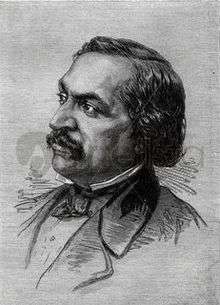Victor Séjour
Juan Victor Séjour Marcou et Ferrand (2 June 1817 – 20 September 1874) was an American expatriate writer who worked in France. Though mostly unknown to later American writers, his short story "Le Mulâtre" ("The Mulatto") is the earliest known work of fiction by a Creole author.[1]
Victor Séjour | |
|---|---|
 | |
| Born | Juan Victor Séjour Marcou et Ferrand 2 June 1817 New Orleans, Louisiana |
| Died | 20 September 1874 (aged 57) Paris, France |
| Occupation | Writer, novelist, playwright |
| Genre | Fiction |
Life
On 2 June 1817 Juan Victor Séjour was born in New Orleans to François Marcou, a free mulatto father from Saint-Domingue (Haiti), and Eloisa Philippe Ferrand, a New Orleans quadroon.[2] His parents were wealthy, and had him educated in a private school. At the age of nineteen he moved to Paris to continue his education and find work. There he met members of the Parisian literary elite, including Cyrille Bissette, publisher of the black-owned journal La Revue des Colonies. Bisette published "Le Mulâtre", Séjour's first work, in 1837. The story of a loyal slave exacting revenge on his cruel master/father for the death of his wife, "Le Mulâtre" contains an indictment of New World slavery that is found in none of Séjour's subsequent work.[1]
Séjour then turned away from written fiction, and composed an ode to Napoleon in 1841 and the verse drama The Jew of Seville in 1844. The latter cemented his reputation as a playwright; he went on to write Richard III, a Shakespeare-inspired costume drama about Richard III of England, that became Séjour's most acclaimed work. Towards the end of his life, however, Séjour's plays fell out of favor, resulting in a decline in his status.
Written in French, "Le Mulâtre" had little effect on American literature, and was not even translated into English until the late 20th century. Its condemnation of slavery, however, anticipates the work of later African-American writers such as Frederick Douglass and William Wells Brown.[1]
The Brown Overcoat (1858)
Séjour tended to leave racism discussions out of his plays, as exemplified by his play The Brown Overcoat. It was a typical artificial comedy of the time period with witty comments and puns; however, it has nothing to do with race or greater issues of the world. This being so, Séjour is still known as a great African-American playwright who led a successful career.[3]
References
- Victor Séjour, Philip Barnard (translator). "The Mulatto." In Nellie Y. McKay and Henry Louis Gates (eds), The Norton Anthology of African American Literature, Second edition, Norton, 2004. ISBN 0-393-97778-1
- Debrunner, Hans Werner, ed. (1979). "Presence and Prestige: Africans in Europe : a History of Africans in Europe Before 1918". p. 194. Retrieved 29 November 2015.
- Shine, Ted (1974). Black Theatre USA Revised and Expanded Edition, Vol. 1: Plays by African Americans, The Early Period 1847 to 1938. New York, NY: Free Press. ISBN 0-684-82308-X.
Bibliography
- Victor Séjour; Philip Barnard (translator). "The Mulatto." In Nellie Y. McKay and Henry Louis Gates (editors). The Norton Anthology of African American Literature Second edition, Norton, 2004. ISBN 0-393-97778-1
- Victor Séjour; Norman R. Shapiro (translator). The Jew of Seville. University of Illinois Press, 2002. ISBN 0-252-02700-0
- Victor Séjour. "Le Mulâtre". Revue des Colonies Paris, 3:9 (March 1837), pages 376–392.
- Brickhouse, Anna. Transamerican Literary Relations and the Nineteenth-Century Public Sphere. Cambridge: Cambridge University Press, 2004.
- Hatch, James V., and Ted Shine. Black Theatre USA: Plays by African Americans. New York: Free, 1996. Print.
Further reading
- Charles Edwards O'Neill, Séjour: Parisian Playwright from Louisiana (University of Southwestern Louisiana, 1995), a book-length biography.
External links
- Works by or about Victor Séjour at Internet Archive
- "Le Mulâtre" (French)
- Piacentino, Ed. Seeds of Rebellion in Plantation Fiction: Victor Séjour's "The Mulatto". Southern Spaces. 28 August 2007
- The Victor Séjour Collection at The Historic New Orleans Collection